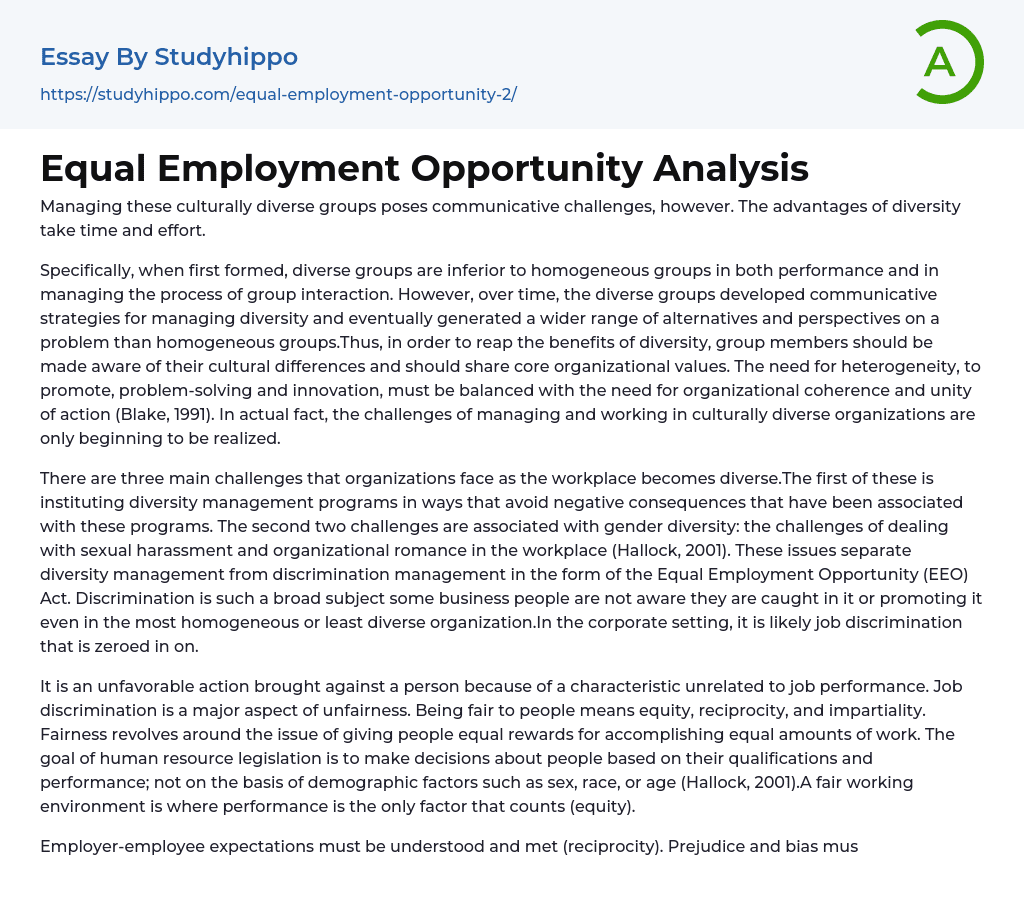Managing these culturally diverse groups poses communicative challenges, however. The advantages of diversity take time and effort.
Specifically, when first formed, diverse groups are inferior to homogeneous groups in both performance and in managing the process of group interaction. However, over time, the diverse groups developed communicative strategies for managing diversity and eventually generated a wider range of alternatives and perspectives on a problem than homogeneous groups.Thus, in order to reap the benefits of diversity, group members should be made aware of their cultural differences and should share core organizational values. The need for heterogeneity, to promote, problem-solving and innovation, must be balanced with the need for organizational coherence and unity of action (Blake, 1991). In actual fact, the challenges of managing and working in culturally diverse organizations are only beginning to be realized.
...There are three main challenges that organizations face as the workplace becomes diverse.The first of these is instituting diversity management programs in ways that avoid negative consequences that have been associated with these programs. The second two challenges are associated with gender diversity: the challenges of dealing with sexual harassment and organizational romance in the workplace (Hallock, 2001). These issues separate diversity management from discrimination management in the form of the Equal Employment Opportunity (EEO) Act. Discrimination is such a broad subject some business people are not aware they are caught in it or promoting it even in the most homogeneous or least diverse organization.In the corporate setting, it is likely job discrimination that is zeroed in on.
It is an unfavorable action brought against a person because of a characteristic unrelated to job performance. Job discrimination is a major aspect
of unfairness. Being fair to people means equity, reciprocity, and impartiality. Fairness revolves around the issue of giving people equal rewards for accomplishing equal amounts of work. The goal of human resource legislation is to make decisions about people based on their qualifications and performance; not on the basis of demographic factors such as sex, race, or age (Hallock, 2001).A fair working environment is where performance is the only factor that counts (equity).
Employer-employee expectations must be understood and met (reciprocity). Prejudice and bias must be eliminated (impartiality) (Blake, 1991). But what makes diversity management close to the execution of EEO is when looking at the two types of discrimination can be exhibited in the workplace: direct and indirect discrimination. Direct discrimination means treating people less favorably than others because of their sexuality, religion or belief.
Indirect discrimination means applying a provision, criterion or practice that disadvantages people of a particular sexual orientation or religion or belief (Cox, 1991). Efforts to combat racial discrimination and racism have figured prominently in the post-World War II history of the United States. The Civil Rights Movement of the 1950s and 1960s won the passage of important legislation such as the Civil Rights Acts. Progress toward integration among blacks and whites has been especially dramatic in the South.Affirmative actions were designed to help correct past patterns of discrimination in employment and spearhead equal or better opportunities among workers (Burk, 2000).
Title VII of the Civil Rights Act of 1964, also known as Equal Employment Opportunity (EEO) mandates, prohibits employers with 15 or more employees from discriminating against applicants and employees in all aspects of employment, including recruiting, hiring, pay, promotion,
training and termination, on the basis of race, color, national origin, religion or gender (Zack, 2000).
- Gender equality essays
- Equality essays
- Segregation essays
- Gender Inequality essays
- Minority essays
- Social Inequality essays
- Gender Inequality In The Workplace essays
- Ageism essays
- Cultural Diversity essays
- Discrimination essays
- Diversity essays
- Gender Discrimination essays
- Multiculturalism essays
- Oppression essays
- Peer Pressure essays
- Racial Profiling essays
- Sexism essays
- American Dream essays
- Barriers To Entry essays
- Capitalism essays
- Central Bank essays
- Compensation essays
- Consumerism essays
- Economic Development essays
- Economic Growth essays
- Economic Inequality essays
- Economic System essays
- Economy essays
- Employment essays
- Export essays
- Finance essays
- Free Trade essays
- Gross Domestic Product essays
- Human Development essays
- Income Inequality essays
- Industry essays
- Inflation essays
- International Business essays
- International Trade essays
- Macroeconomics essays
- Materialism essays
- Max Weber essays
- Microeconomics essays
- Minimum Wage essays
- Monetary Policy essays
- Monopoly essays
- Pricing essays
- Profit essays
- Recession essays
- resources essays




